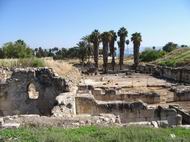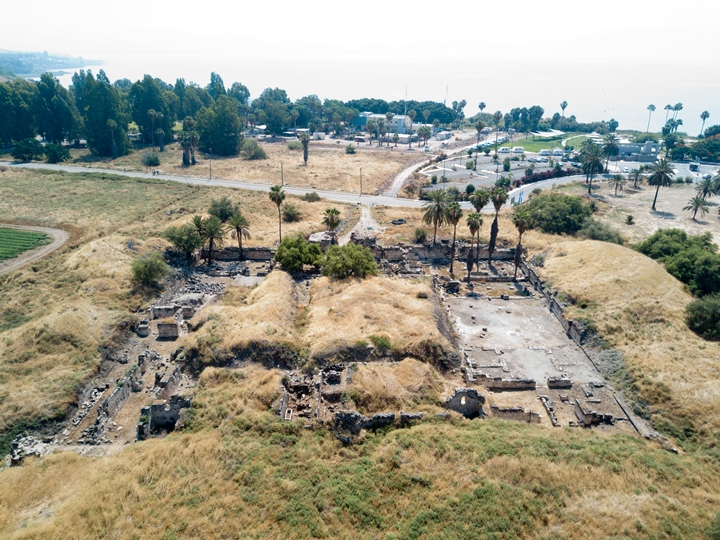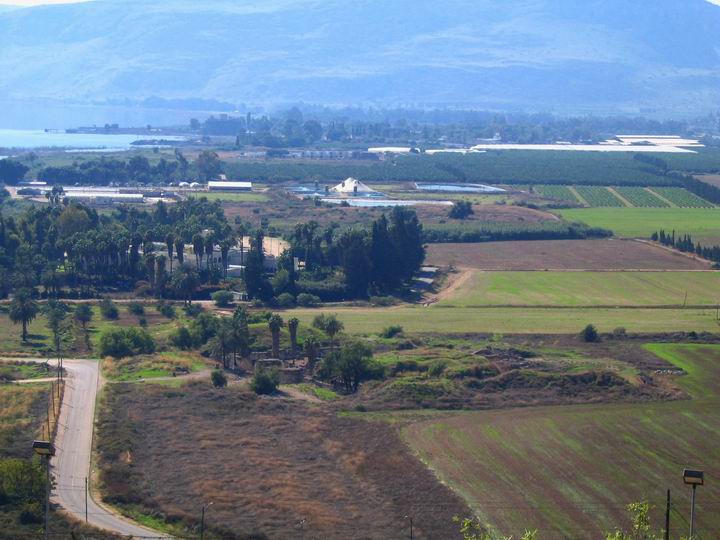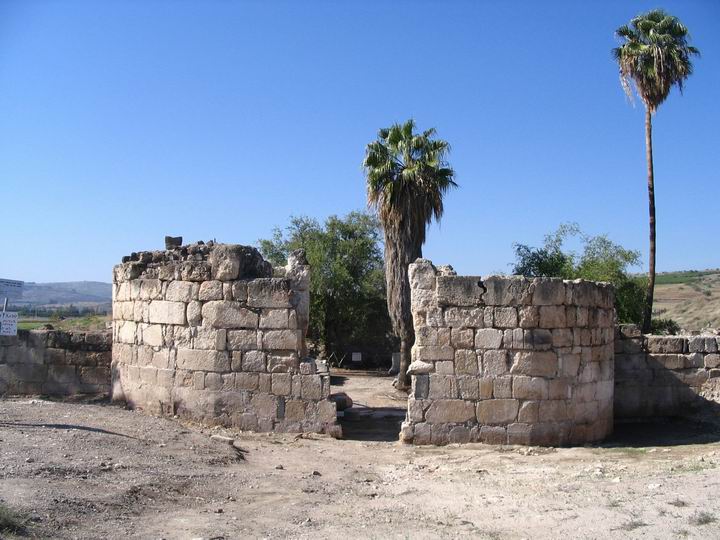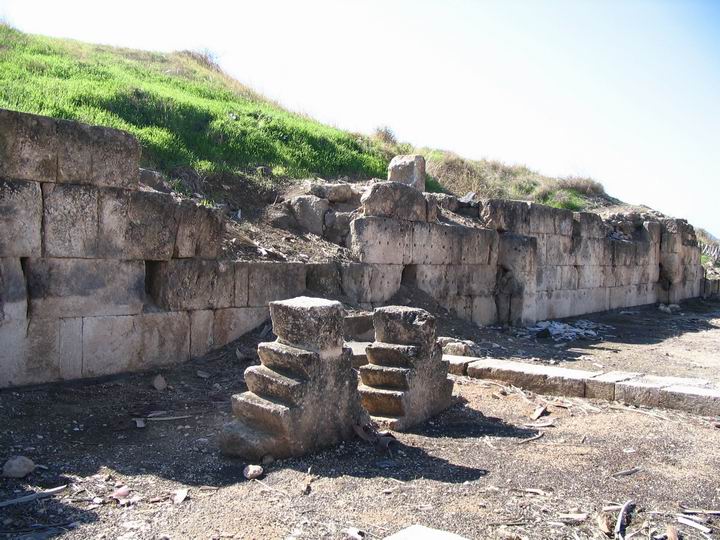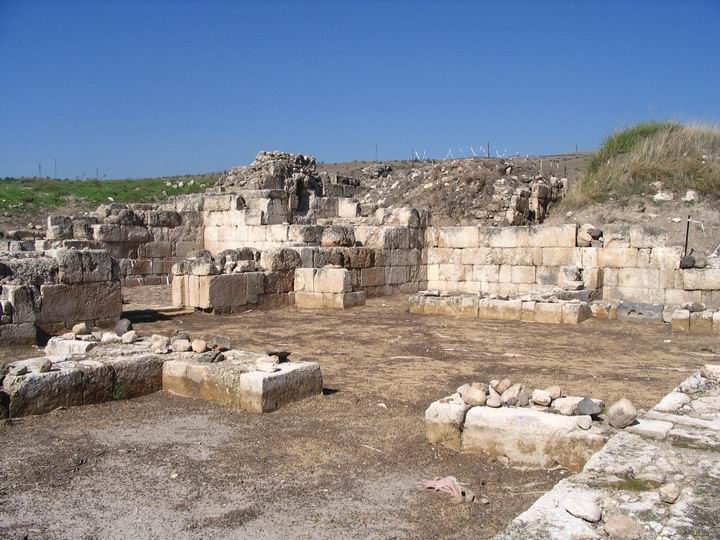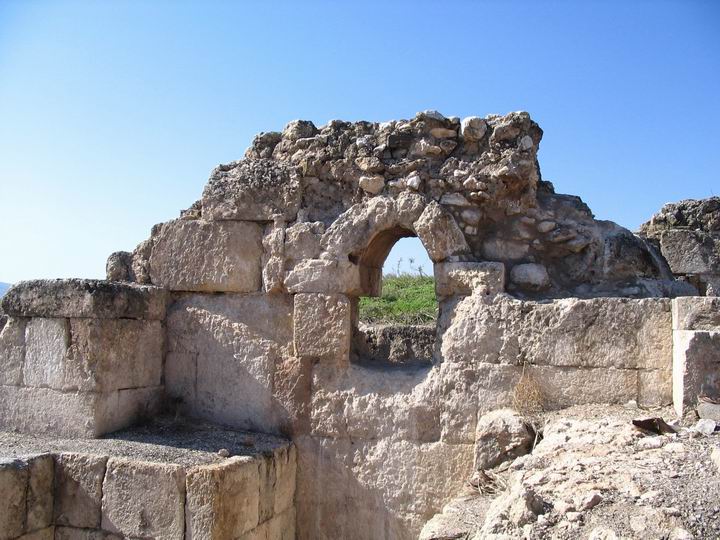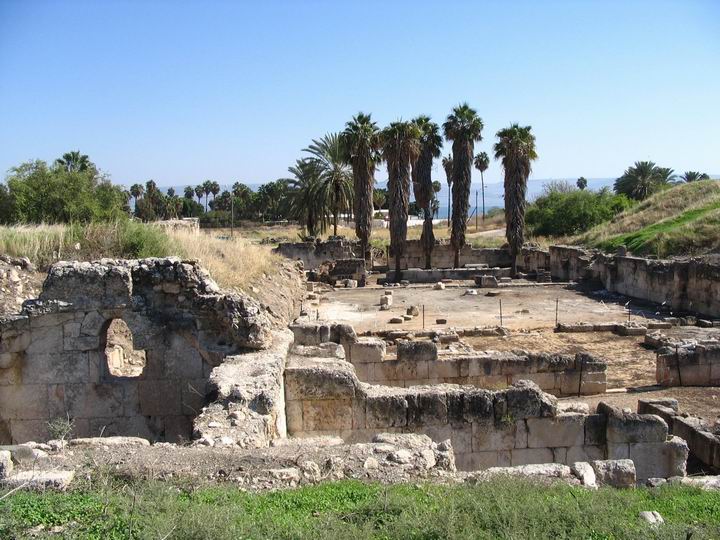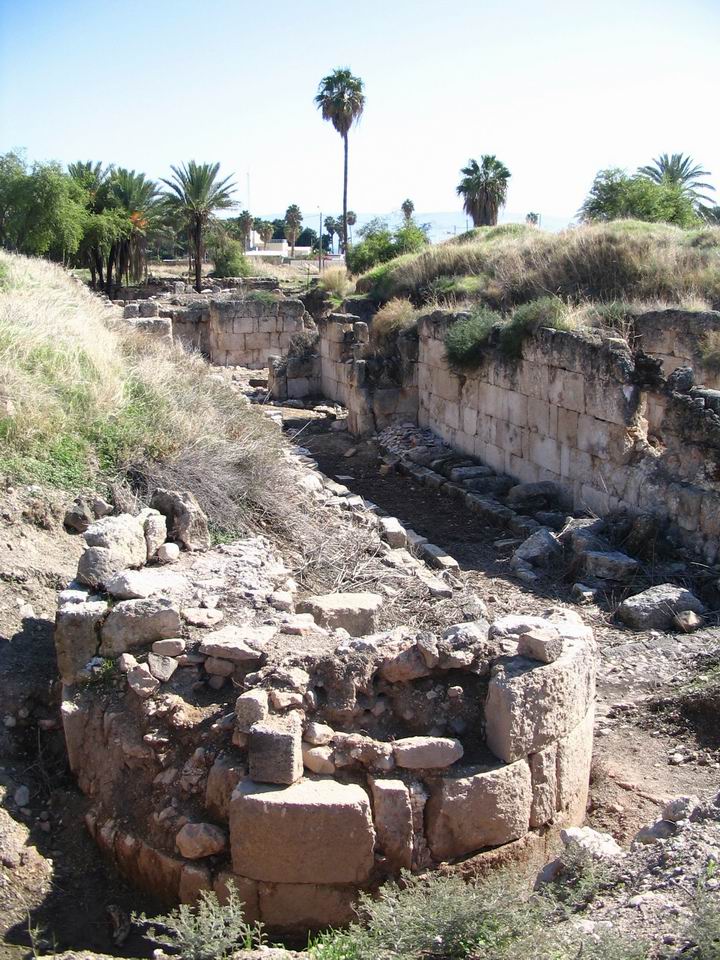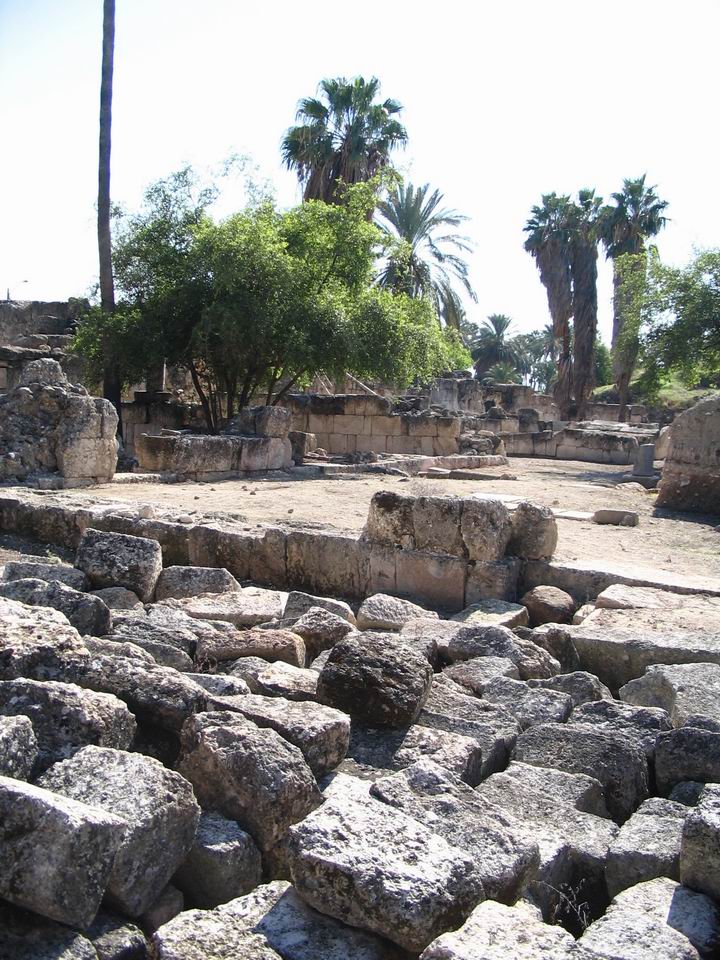Ruins of a grand winter palace for the Omayyad rulers from Damascus. Built in the 8th century AD near Tel Kinneret.
Home > Sites > Sea of Galilee > Khirbet Minya (Horvat Minnim)
Contents:
Background
Location
Map
History
Photos
Video
References
Etymology
Links
Background:
Ruins of an early Arab period palace on the route of the ancient road from Tiberias to the north of the sea of Galilee (Capernaum). It served as a winter palace for the Omayyad rulers of Damascus.
A Khan (road hostel) was located nearby, closer to the hill of Tel Kinneret, but there are no traces of it today. It served the caravans from Damascus to Egypt.
Location:
The site is located at the north corner of the Sea of Galilee. While driving from Tiberias to Capernaum, after about 10KM and just before Tel Kinneret, there is a right turn to Karei Deshe youth hostel and Khurvat Minya. This road gets you to the entrance of Khurvat Minya.
Aerial Map:
This is the aerial view of the area from the south. The ruins of the palace are are located in the field south of Tel Kinneret.
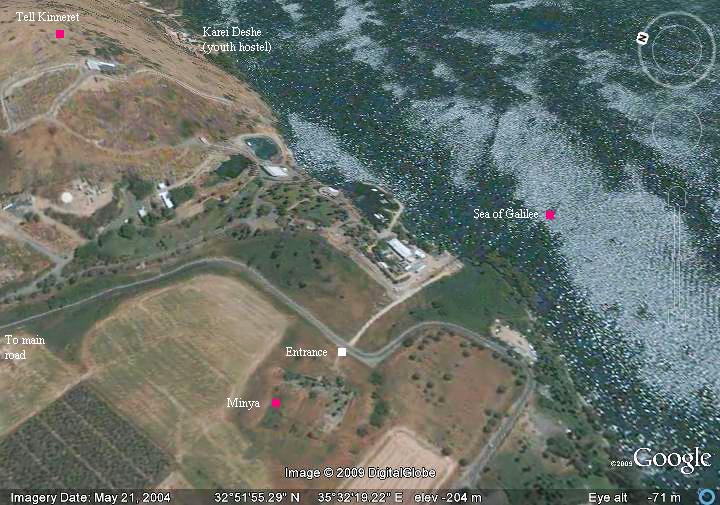
History:
In earlier times the site was located on the major road that connected Egypt to Syria. It is very close to Capernaum, which is located 3 Km to the east. Jesus must have passed this very spot several times on his travels from Capernaum to the Galilee, Nazareth, Judea and Jerusalem.
A Roman/Byzantine Jewish village called Ein-Te’ena (Hebrew for “Spring of the Fig”) is referred in the Talmud (4th century AD). It was probably located around the spring which is located closer to the hill. The Arabic name of the spring, Ein e-Tina (spring of the fig tree), preserved the name of the village.
In the 5th century AD a Byzantine structure was located in the area of Minya.
Minya is an Arab palace, built by the Omayyad Khalif caliph al-Walid I (705-715) from Damascus to serve as a winter palace. An inscription of this ruler was found on a stone in the palace. It was built over the Byzantine building.
The palace was destroyed in the severe earthquake of 749 AD that caused an havoc throughout the Galilee .
- Ottoman period
Conder and Kitchener surveyed this area during the Survey of Western Palestine (SWP), commissioned by the Palestine Exploration Fund (PEF) in 1873. A section of their map is seen here. Kh. Minia is marked in the center of the map. The spring of ‘Ain et Tineh is located near it, as well as Khan Minia. Tell Kinneret (Kh. el ‘Oreimeh) is to the north of the site. Tabghah is farther along the shore.
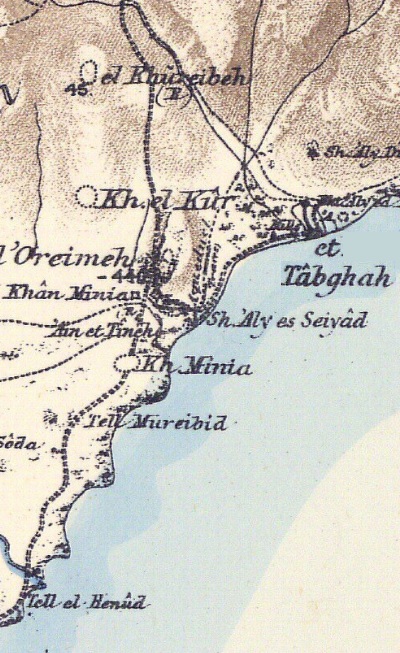
Part of Map Sheet 6 of Survey of Western Palestine, by Conder and Kitchener, 1872-1877.
(Published 1880, reprinted by LifeintheHolyLand.com)
- Modern period
Its ruins were first excavated in 1932–1939 by E.A. Mader and O. Puttrich-Reignard, on behalf of the German Görres Society and the Museum of Islamic Art of Berlin. Some of its excavated items are on display in the museum in Berlin.
The excavated ruins are open to the public.
Photos:
An aerial view of Khurvat Minya was captured by a drone from the west side. The Sea of Galilee is seen in the background.
Click on the photo to view it in higher resolution…
A view of the site from Tel Kinneret, seen in the center of the next image. In the background is Ginnosar, and behind it – the Arbel Cliffs on the right and the sea of Galilee on the left.
This is the entrance to the palace from the sea (east) side:
On the south side – the ruins of the palace:
The view of the palace on the west side:
West side window:
View of the palace from the west side is in the next photo. The sea of Galilee is seen behind the palm trees.
A view of the north side of the palace:
View of the east side of the palace:
Video:
![]() The following YouTube video shows a flight over the site:
The following YouTube video shows a flight over the site:
Other References:
(a) “Haifa” Dec 26 24, 1884
- Laurence Oliphant “Haifa, or Life in Modern Palestine”
His article was published on Dec 26, 1884, with the title “Sea of the Galilee”, where he tells his readers about his visit to the site of Minya. At his times the scholars still debated whether Minya was Capernaum, the city of Jesus, or was it located in the ruins north-east to Minya, called Tell-Khum. His opinion that Minya was not the city of Jesus, and he later visited the ruins of Tell-Khum.
It is a recommended book for the period of rediscovering the Holy Land.
(b) “The Land and the book” W. M. Thomson
In this traveler’s book of 1861 (“The Land and the Book” Volume 2) he wrote about the spring near the site, on the south side of Tel Kinneret, named ‘Ain et Tineh (Tiny). Thomson wrote about it (p. 408):
“’Ain et Tiny is the most northern fountain of the plain, but so low and so near to the lake—on the shore, in fact—that it could not have been extensively used. That portion of the plain is not so well watered as the southern, and the stream from ’Ain et Tabi-ghah appears to have been brought into that region to supply the deficiency. In the summer-time all the streams which enter the plain disappear before they reach the lake….”.
Thomson’s illustration of the spring and Tel Kinneret behind it (p. 412):
“’Ain et Tiny is the most northern fountain of the plain, but so low and so near to the lake—on the shore, in fact—that it could not have been extensively used. That portion of the plain is not so well watered as the southern, and the stream from ’Ain et Tabi-ghah appears to have been brought into that region to supply the deficiency. In the summer-time all the streams which enter the plain disappear before they reach the lake….”.
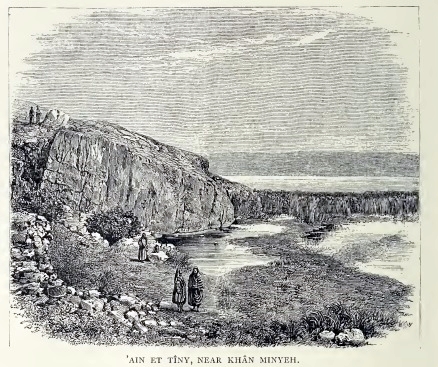
He continued describing the aqueduct found above the spring (p. 415):
Lieutenant Kitchner adds: “Round the southern brow of this hill [above ’Ain et Tiny], where’the rock runs steeply down to the lake, is the rock-cut aqueduct now used as a road, and described by Major Wilson. It is fifty-two feet four inches above the sea, which is almost perpendicularly beneath it at one part, and has a fall of seven feet in the mile: the water would not have been carried far on the plain, but would have watered the gardens round Khurbet Minyeh.”
Etymology (behind the name):
- Minya, Minyeh – this name may have originated from the Greek word “moni” – a dwelling.
- Horvat Minnim – the Hebrew name of the ruins.
Links:
* External:
- Excavations (2005) – press release (in Hebrew)
- Horvat Minnim – Hans-Peter Kuhnen, Miriam Pines and Oren Tal [Hadashot Arkheologiyot V130 2018]
- Discover Islamic art – Berlin
- Archaeological destruction layers – Erez Hassul (pdf 125 pages; 2015) – see pages 17-25 on earthquake damage to Horvat Minnim
* Internal:
- Drone Aerial views – collection of Biblical sites from the air
- Earthquakes
* Nearby sites:
- Tel Kinneret – site above Horvat Minya
- Lower Tsalmon stream – mills, probably where the sugar canes were processed
- Skull cave, Amud stream – prehistoric cave
BibleWalks.com – walk with us through the sites of the Holy Land
Tell Kinneret <<<–previous site—<<<All Sites>>>–-next Sea of Galilee site –>>> Hammat Gader
This page was last updated on Apr 20, 2023 (misc updates, earthquake)
Sponsored links:
